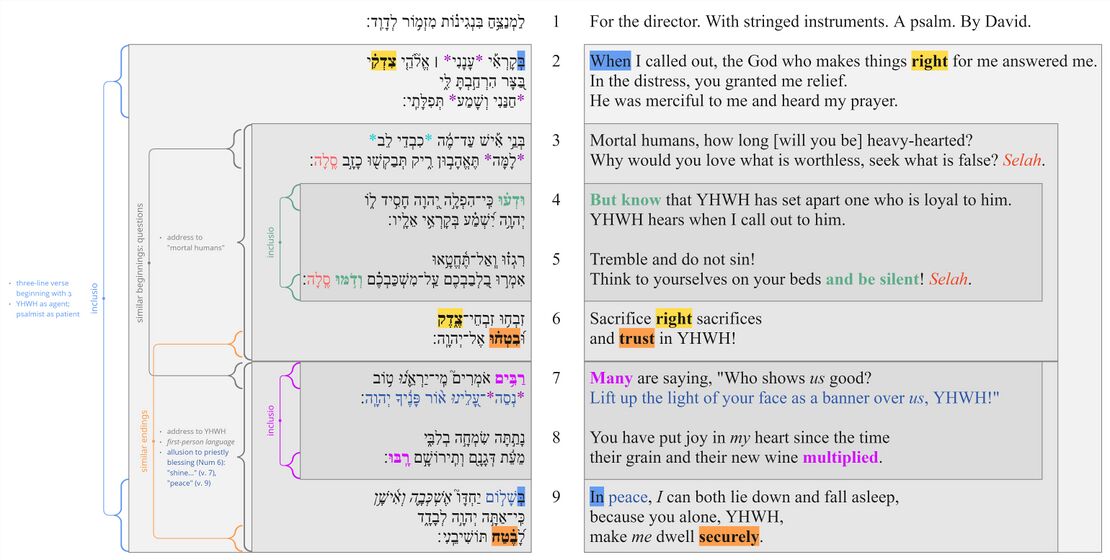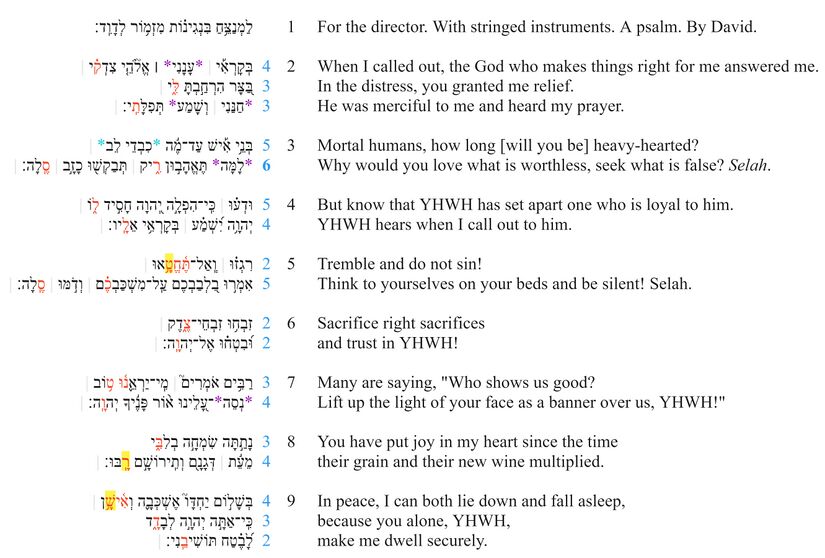Psalm 4 Poetic Structure
Poetic Structure
In poetic structure, we analyse the structure of the psalm beginning at the most basic level of the structure: the line (also known as the “colon” or “hemistich”). Then, based on the perception of patterned similarities (and on the assumption that the whole psalm is structured hierarchically), we argue for the grouping of lines into verses, verses into sub-sections, sub-sections into larger sections, etc. Because patterned similarities might be of various kinds (syntactic, semantic, pragmatic, sonic) the analysis of poetic structure draws on all of the previous layers (especially the Discourse layer).
Poetic Macro-structure
If an emendation or revocalization is preferred, that emendation or revocalization will be marked in the Hebrew text of all the visuals.
| Emendations/Revocalizations legend | |
|---|---|
| *Emended text* | Emended text, text in which the consonants differ from the consonants of the Masoretic text, is indicated by blue asterisks on either side of the emendation. |
| *Revocalized text* | Revocalized text, text in which only the vowels differ from the vowels of the Masoretic text, is indicated by purple asterisks on either side of the revocalization. |
| v. 1 For the director. With stringed instruments. A psalm. By David. | Superscription | |||
| v. 2 When I called out, the God who makes things right for me answered me. In the distress, you granted me relief. He was merciful to me and heard my prayer. | Relief | The God who makes things right for me relieved my distress. | joy, relief | |
| v. 3 Mortal humans, how long [will you be] heavy-hearted? Why would you love what is worthless, seek what is false? Selah. | Invitation | Everyone, stop seeking false gods! They will not satisfy. Sacrifice right sacrifices and trust in YHWH! |
impatience expectation | |
| v. 4 But know that YHWH has set apart one who is loyal to him. YHWH hears when I call out to him. | ||||
| v. 5 Tremble and do not sin! Think to yourselves on your beds and be silent! Selah. | ||||
| v. 6 Sacrifice right sacrifices and trust in YHWH! | ||||
| v. 7 Many are saying, "Who shows us good? Lift up the light of your face as a banner over us, YHWH!" | Blessing | Many are celebrating your blessing and saying, “Lift up the light of your face as a banner over us, YHWH!” You bless those who trust in you with joy, peace, and security. |
peace, confidence | |
| v. 8 You have put joy in my heart since the time their grain and their new wine multiplied. | ||||
| v. 9 In peace, I can both lie down and fall asleep, because you alone, YHWH, make me dwell securely. | ||||
Notes
The poetic structure of this psalm is relatively difficult to determine, and many different structures have been proposed.[1] It is almost impossible for any given structure to account for all of the verbal repetitions (see Repeated Roots chart)[2] and other salient discourse features. The structure proposed here is based on the following repetitions and discourse features:
- The shifts in addressee divide the psalm into three parts: v. 2 (address to God), vv. 3-6 (address to "mortal humans"), vv. 7-9 (address to God).[3]
- The last two parts—the two main parts of the psalm (vv. 3-6; vv. 7-9)—each begin with a question (v. 3: "how long...why...?" v. 7: "who...?) and end with the root בטח (vv. 6b, 9c).[4]
- Verse 6 is the central verse in the psalm, insofar as it repeats roots from the first and last lines of the psalm: צדק (vv. 2a, 6b) and בטח (vv. 6b, 9c). "Thus, beginning and end of the whole are tied to the centre."[5] It is also the shortest verse in the psalm.
- On either side of this central verse is a two-verse unit bound by an inclusio.
- Verses 7-8 are clearly demarcated as a unit by the repetition of רַבִּים and רָבּוּ as the first and last word respectively.
- Verses 4-5 are demarcated as a unit by the repetition of similar imperatives: ודעו at the beginning of v. 4 and ודמו at the end of v. 5. These forms differ only by a single letter.
- Selah, together with the inclusio around vv. 4-5, demarcates sub-units within the second part of the psalm, the address the the mortal humans (vv. 3-6).
- The whole psalm is bound by an inclusio. Verses 2 and 9 are the only three-line verses in the psalm, and both begin with a bet preposition. They also feature YHWH as the agent and the psalmist as the patient. Note also the similarities between being in a broad space (v. 2b) and dwelling in security (v. 9bc).
Line Divisions
Line division divides the poem into lines and line groupings. We determine line divisions based on a combination of external evidence (Masoretic accents, pausal forms, manuscripts) and internal evidence (syntax, prosodic word counting and patterned relation to other lines). Moreover, we indicate line-groupings by using additional spacing.
When line divisions are uncertain, we consult some of the many psalms manuscripts which lay out the text in lines. Then, if a division attested in one of these manuscripts/versions influences our decision to divide the text at a certain point, we place a green symbol (G, DSS, or MT) to the left of the line in question.
| Poetic line division legend | |
|---|---|
| Pausal form | Pausal forms are highlighted in yellow. |
| Accent which typically corresponds to line division | Accents which typically correspond to line divisions are indicated by red text. |
| | | Clause boundaries are indicated by a light gray vertical line in between clauses. |
| G | Line divisions that follow Greek manuscripts are indicated by a bold green G. |
| DSS | Line divisions that follow the Dead Sea Scrolls are indicated by a bold green DSS. |
| M | Line divisions that follow Masoretic manuscripts are indicated by a bold green M. |
| Number of prosodic words | The number of prosodic words are indicated in blue text. |
| Prosodic words greater than 5 | The number of prosodic words if greater than 5 is indicated by bold blue text. |
If an emendation or revocalization is preferred, that emendation or revocalization will be marked in the Hebrew text of all the visuals.
| Emendations/Revocalizations legend | |
|---|---|
| *Emended text* | Emended text, text in which the consonants differ from the consonants of the Masoretic text, is indicated by blue asterisks on either side of the emendation. |
| *Revocalized text* | Revocalized text, text in which only the vowels differ from the vowels of the Masoretic text, is indicated by purple asterisks on either side of the revocalization. |
Notes
- The proposed line division agrees with the MT accents as interpreted by de Hoop and Sanders (2022, §6) in every verse except for v. 3, where we have emended the text based on the Septuagint, and v. 5, where there is additional division after מִשְׁכַּבְכֶ֗ם. The proposed line division for v. 3 agrees with the Septuagint. The proposed division agrees with the Septuagint for all other verses except for v. 6 (where the Septuagint has only one line), v. 9 (where the Septuagint combines v. 9bc into one line), and possibly also v. 5 (where Rahlfs' edition reflects a different text than MT [see grammar note]; in this verse, however, our proposed line division agrees with Sinaiticus and Vaticanus, which might represent the earlier Greek division).
- The first verse (v. 2) and the last verse (v. 9) are three-line verses. All of the other verses are two-line verses.
- The two longest lines are the two lines ending with סֶלָה (vv. 3b, 5b).




